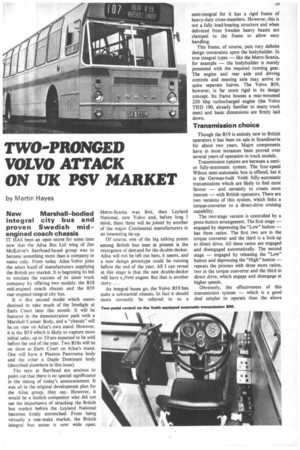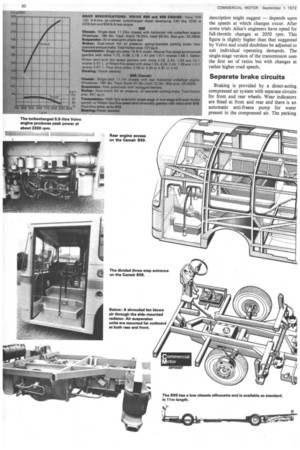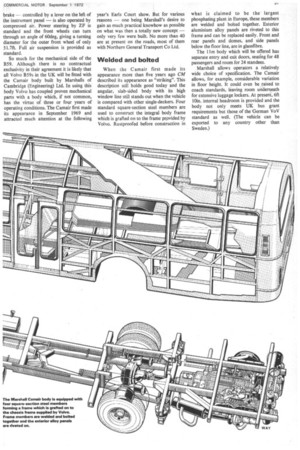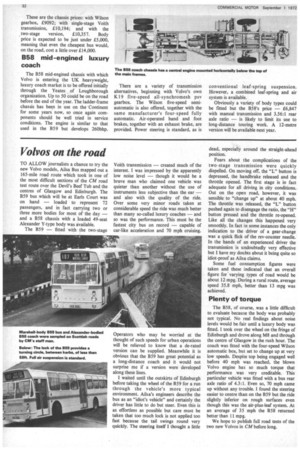TWO-PRONGED VOLVO ATTACK ON UK PSV MARKET
Page 31

Page 32

Page 33

Page 34

If you've noticed an error in this article please click here to report it so we can fix it.
by Martin Hayes New Marshall-bodied integral city bus and proven Swedish midengined coach chassis
IT HAS been an open secret for some time now that the Ailsa Bus Ltd wing of Jim McKelvie's Barrhead-based group was to become something more than a company in name only. From today Ailsa-Volvo joins the select band of manufacturers supplying the British psv market. It is beginning its bid to emulate the success of its sister truck company by offering two models: the 858 mid-engined coach chassis and the B59 rear-engined integral city bus.
It is this second model which seems destined to take much of the limelight at Earls Court later this month. It will be featured in the demonstration park with a Marshall Camair Body, and a "chassis" will be on view on Ailsa's own stand. However, it is the B58 which is likely to capture more initial sales; up to 50 are expected to be sold before the cnd of the year. Two B58s will be on show at Earls Court on Ailsa's stand. One will have a Plaxton Panorama body and the other a Duple Dominant body (described elsewhere in this issue).
The men at Barrhead are anxious to point out that there is no special significance in the timing of today's announcement. It was all in the original development plan for the Ailsa group, they say. However, it would be a foolish competitor who did not see the importance of attacking the British bus market before the Leyland National becomes firmly entrenched. From being virtually a one-make market, the British integral bus scene is now wide open. Met ro-Scaniawas first, then Leyland National, now Volvo and, before long I think, these three will be joined by another of the major Continental manufacturers in an interesting tie-up.
Of course, one of the big talking points among British bus men at present is the resurgence of demand for the double-decker. Ailsa will not be left out here, it seems, and a new design prototype could be running before the end of the year. All I can reveal at this stage is that the new double-decker will have a front engine. But that is another story....
As integral buses go, the Volvo 859 has quite a substantial chassis. In fact it should more correctly be referred to as a semi-integral for it has a rigid frame of heavy-duty cross-members. However, this is not a fully load-bearing structure and when delivered from Sweden heavy beams are clamped to the frame to allow easy handling.
This frame, of course, puts very definite design constraints upon the bodybuilder. In true integral types — like the Metro-Scania, for example — the bodybuilder is merely presented with the required running gear. The engine and rear axle and driving controls and steering axle may arrive in quite separate halves. The Volvo B59, however, is far more rigid in its design concept. Its frame houses a rear-mounted 230 bhp turbocharged engine (the Volvo THD 100, already familiar to many truck men) and basic dimensions are firmly laid down.
Transmission choice
Though the 859 is entirely new to British operators it has been on sale in Scandinavia for about two years. Major components have in most instances been proved over several years of operation in truck models.
Transmission options are between a semior fully-automatic system. The four-speed Wilson semi-automatic box is offered, but it is the German-built Voith fully-automatic transmissions which are likely to find most favour — and certainly to create most interest — with British operators. There are two versions of this system, which links a torque-converter to a direct-drive cruising capability.
The two--stage version is controlled by a press-button arrangement. The first stage — engaged by depressing the "Low" button — has three ratios. The first two are in the torque converter and the third is a lock-up to direct drive. All these ratios are engaged and disengaged automatically. The second stage — engaged by releasing the "Low" button and depressing the "High" button — repeats the process with three more ratios, two in the torque converter and the third in direct drive, which engage and disengage at higher speeds.
Obviously, the effectiveness of this transmission system — which is a good deal simpler to operate than the above description might suggest — depends upon the speeds at which changes occur. After some trials Ailsa's engineers have opted for full-throttle changes at 2050 rpm. This figure is slightly higher than that suggested by Volvo and could doubtless be adjusted to suit individual operating demands. The single-stage version of the transmission uses the first set of ratios but with changes at rather higher road speeds.
Separate brake circuits
Braking is provided by a direct-acting compressed air system with separate circuits for front and rear wheels. Wear indicators are fitted at front and rear and there is an automatic anti-freeze pump for water present in the compressed air. The parking brake — controlled by a lever on the left of the instrument panel — is also operated by compressed air. Power steering by ZF is standard and the front wheels can turn through an angle of 60deg, giving a turning diameter for the outer front wheel of only 51.7ft. Full air suspension is provided as standard.
So much for the mechanical side of the B59. Although there is no contractual exclusivity in their agreement it is likely that all Volvo B59s in the UK will be fitted with the Camair body built by Marshalls of Cambridge (Engineering) Ltd. In using this body Volvo has coupled proven mechanical parts with a body which, if not common, has the virtue of three or fonr years of operating conditions. The Camair first made its appearance in September 1969 and attracted much attention at the following year's Earls Court show. But for various reasons — one being Marshall's desire to gain as much practical knowhow as possible on what was then a totally new concept — only very few were built. No more than 40 are at present on the roads, most of them with Northern General Transport Co Ltd.
Welded and bolted
When the Camair first made its appearance more than five years ago CM described its appearance as "striking". This description still holds good today and the angular, slab-sided body with its high window line still stands out when the vehicle is compared with other single-deckers. Four standard square-section steel members are used to construct the integral body frame which is grafted on to the frame provided by Volvo. Rustproofed before construction in what is claimed to be the' largest phosphating plant in Europe, these members are welded and bolted together. Exterior aluminium alloy panels are riveted to this frame and can be replaced easily. Front and rear panels and domes, and side panels below the floor line, are in glassfibre.
The 1 1m body which will be offered has separate entry and exit doors, seating for 48 passengers and room for 24 standees.
Marshall allows operators a relatively wide choice of specification. The Camair allows, for example, considerable variation in floor height. It could even be .raised to coach standards, leaving room underneath for extensive luggage lockers. At present, 6ft 10in, internal headroom is provided and the body not only meets UK bus grant requirements but those of the German VoV standard as well. (The vehicle can be exported to any country other than Sweden.)
These are the chassis prices: with Wilson gearbox, £9092; with single-stage Voith transmission, £10,194; and with the • two-stage version, £10,357. Body price is expected to be just under £5,000, meaning that even the cheapest bus would, on the road, cost a little over £14,000.
B58 mid-engined luxury coach
The B58 mid-engined chassis with which Volvo is entering the UK heavyweight, luxury coach market is to be offered initially through the Yeates of Loughborough organization. Up to 50 could be on the road before the end of the year. The ladder-frame chassis has been in use on the .Continent for some years now, so once again components should be well tried in service conditions. The engine is similar to that used in the B59 but develops 260bhp.
There are a variety of transmission alternatives, beginning with Volvo's own K19 five-speed all-synchromesh psv gearbox. The Wilson five-speed semiautomatic is also offered, together with the same manufacturer's four-speed fully automatic. Air-operated hand and foot brakes, together with an exhaust brake, are provided. Power steering is standard, as is conventional leaf-spring suspension. However, a combined leaf-spring and air system is available.
Obviously a variety of body types could be fitted but the B58's price — £6,847 with manual transmission and 3.56:1 rear axle ratio — is likely to limit its use to long-distance touring work. A 12-metre version will be available next year.


































































































